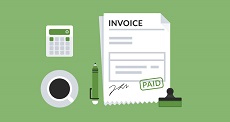
Many business-to-business (B2B) or business-to-government (B2G) companies have to wait weeks or months for their customers to pay. This sometimes causes cash flow issues, as earnings get stuck in the form of unpaid invoices instead of being available for use.
Through invoice factoring, you can free up your capital without being in debt or selling equity. How? You get a cash advance in exchange for your outstanding invoices. Instead of waiting for weeks or months for your customers to pay, you can leverage those invoices to get access to funds within a few days. With better cash flow, you can run your business more smoothly.
In invoice factoring, a business owner sells unpaid invoices to a factoring company (aka the factor) in exchange for a cash advance amounting to 70%-90% of the total invoice value. The remaining value is held as reserve by the factor. After the invoices have been paid by the client’s customers, the factor deducts its fees from the reserve then gives the remainder to the client.
For example, let’s say you have an outstanding invoice amounting to $100,000, the advance rate is 85%, the factoring fee is 1% per week, and there is a 3% processing fee. After selling the invoice, you immediately get $85,000 as advance and the factor keeps $15,000 as reserve. If the customer pays the invoice after 3 weeks, the factor takes away the 3% processing fee ($3,000) plus the 3% factoring fee ($3,000) then sends you the remaining $9,000. So from your $100,000 invoice, you get a total of $94,000.
Note that there is a similar financing option called invoice financing. Invoice factoring and invoice financing are different options, but the two terms are sometimes used interchangeably. With invoice factoring, because you have sold the invoice to the factor, the factor will collect the payment from your customers. With invoice financing, meanwhile, you are still the one in charge of payment collection.
This is a significant difference to business owners who do not want a third party contacting their customers, or even the customers knowing that the company is borrowing money. So if you’re thinking of getting funding through invoice factoring, be sure you are clear as to who has to collect the payment and that you are comfortable with the arrangement.
Invoice factoring vs. business loans
The fees deducted by the factor are sometimes high, but many businesses still choose invoice factoring over business loans because it is fast and easy.
Traditional lenders have very strict requirements. Moreover, loan applications involve a ton of paperwork and can take months, which is frustrating given their dismal approval rate. In contrast, with invoice factoring, the application process is convenient and requires minimal paperwork. The approval is quick, and you receive the funds after just 1 or 2 business days.
It is also easier for B2B and B2G companies to be approved for invoice factoring because the unpaid invoices already serve as your collateral. Thus, factoring companies do not care so much about how long you have been in business, how much your company earns each year or what your credit score is. As far as they are concerned, you have already made the sale; all that is left is to collect the payment from your customers after a few weeks or months, so they are more concerned with the creditworthiness of your customers.
Invoice factoring is also less stressful for business owners, simply because they are not taking on debt. As long as you have financially responsible customers, there is nothing to worry about. You do not have to think about any monthly or weekly payments, so you can concentrate on more important matters, such as improving your work processes and growing your business.
In addition, some loans have limitations on what things you can spend the money on. Some loans, for example, can only be used as working capital (but not to buy real estate) or only for buying equipment (but not inventory). There are no such restrictions with invoice factoring.
Bottom Line
Invoice factoring is a business loan alternative available to B2B and B2G companies that want to have quick access to capital without waiting for outstanding invoices to be paid, and without taking on debt or giving up equity. The fees are higher than with traditional lenders, but this funding option offers convenience, flexibility, speed, and freedom from monthly payments.






